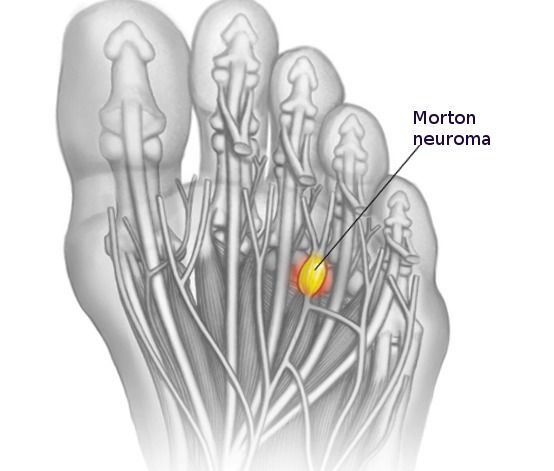Morton’s Neuroma
Morton’s Neuroma is the swelling of the lining of the nerve at the junction of where it typically splits into the third or fourth toe. It can affect the nerves going into other toes. Pain and discomfort is felt at the front of the foot which can often radiate into the third or fourth toes.
REQUEST AN APPOINTMENT
Causes
Morton’s neuroma affects the ball of the foot. It is a condition which can cause the same kind of sensation felt when standing on a pebble which got into a shoe, or when standing on folds in the sock. Painful and uncomfortable symptoms, as well as weakness, are felt after the thickening of the tissue surrounding nerves which go to the toe.
Activities which exert repeated pressure on the toes, causing injury or irritation to the nerves, are sometimes known to cause Morton’s neuroma.
There are several known risk factors which can contribute to Morton’s neuroma, including playing certain sports which could cause repetitive trauma to the feet; participating in sports and activities which require tight shoes, such as rock climbing or skiing; wearing high heels or shoes which fit too tightly; and foot deformities like hammertoes, bunions, flat feet or high arches.
Symptoms
In many cases, there are no marks, discolouration, or lumps which can superficially indicate Morton’s neuroma.
The typical symptoms of Morton’s neuroma can include discomfort at the front of the foot, the feeling of standing on a pebble which has entered the shoe or a fold in the sock; a tingling or numb sensation in the toes; and a burning sensation from the ball of the foot to the toe.

Diagnosis
A diagnosis of Morton’s neuroma can be made via a physical examination, in which the doctor presses on the foot to identify a tender spot or mass. There can also be a clicking sensation between the foot bones. Imaging tests such as x-rays, magnetic resonance imaging (MRI) or ultrasounds can be used for a number of purposes when making a diagnosis of Morton’s neuroma.
Treatment
There are some lifestyle and home remedies which are understood to be effective in addressing Morton’s neuroma. These include ice massage, which can reduce pain; nonsteroidal anti-inflammatory medications (NSAID) such as naproxen and ibuprofen; breaks from high impact activities which can exert repeated pressure on the feet; and changing footwear to looser fitting or more comfortable shoes.
Therapy to ease the symptoms of Morton’s neuroma can involve footpads, injections of steroids and local anaesthetic and arch supports which serve to ease the pressure on the nerve. These can either be custom made inserts which have been specifically moulded to your foot contours, or inserts which are bought over the counter.
For cases in which conservative treatments have proven ineffective, surgical treatments can be advised by your doctor. Procedures can include removal of the nerve, in order to stop the impingement of the nerve at the ball of the foot; and decompression surgery, which eases the pressure on the nerve by cutting into areas such as the ligament in front of the foot which binds some of the bones together.
In general, there is a short recovery time, typically two weeks in a bandage and a special shoe after which time sutures are removed. Patients are able to walk home straight away after surgery, resting and elevating the foot as recommended for the first two weeks. Return to sporting activities can typically start after six weeks.
As with all foot surgery it is normal for swelling to persist for some months after surgery and is completely normal. This swelling will eventually completely subside with time and can take up to 12 months but often goes well before this.
Ankle pain can be distressing, especially if you're not sure what options are open to you. If you're wondering if surgery could help you, book an appointment.
* Routine private appointments either face to face or remotely are available
